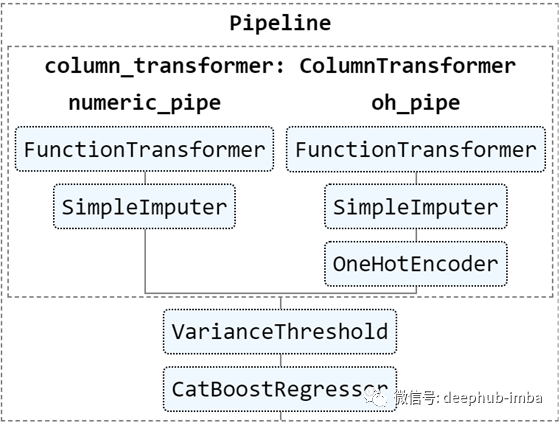如果你是Scikit-Learn的粉丝,那么0.24.0版本你一定会喜欢。里面新特性包括model_selection模块中的两个实验性超参数优化器类:HalvingGridSearchCV和HalvingRandomSearchCV。
和它们的近亲GridSearchCV和RandomizedSearchCV一样,它们使用交叉验证来寻找最佳超参数。然而,他们的连续二分搜索策略并不是独立搜索超参数集候选项,而是“开始用少量资源评估所有候选项,并使用越来越多的资源迭代地选择最佳候选项。”默认资源是样本的数量,但用户可以将其设置为任何正整数模型参数,如梯度增强轮。因此,减半方法具有在更短的时间内找到好的超参数的潜力。
我通读了Scikit-Learn的“Comparison between grid search and successive halving”示例并进行了测试,但是由于总共花费了11秒的时间,因此我仍然不清楚使用减半与穷举方法对实际操作的影响。因此,我决定建立一个实验来回答以下问题:
- HalvingGridSearchCV与GridSearchCV相比要快多少?
- HalvingGridSearchCV是否仍选择与GridSearchCV相同的超参数集?
我将运行并比较3个搜索:
- GridSearchCV
- 使用默认的“ n_samples”资源进行HalvingGridSearchCV
- 使用CatBoost的“ n_estimators”作为资源的HalvingGridSearchCV
升级Scikit-Learn
第一步是将Scikit的版本升级到0.24.0,并确保可以导入正确的版本。
# !! pip install scikit-learn --upgrade
import sklearn
print(sklearn.__version__)
0.24.0
加载数据集
我使用Kaggle的爱荷华州艾姆斯房价数据集进行了测试。它具有1,460个观测值和79个特征。因变量是房屋的SalePrice。
import numpy as np
import pandas as pd
DEP_VAR = 'SalePrice'
train_df = pd.read_csv('../kaggle/input/house-prices-advanced-regression-techniques/train.csv')\
.set_index('Id')
y_train = train_df.pop(DEP_VAR)
创建处理管道和模型
我还编写了一个名为pipeline_ames.py的脚本。它实例化包含某些功能转换和CatBoostRegressor的管道。我在下面绘制了它的视觉表示。
from sklearn import set_config
from sklearn.utils import estimator_html_repr
from IPython.core.display import display, HTML
from pipeline_ames import pipe
set_config(display='diagram')
display(HTML(estimator_html_repr(pipe)))

实验测试
grid_search_paramsdictionary包含在3个搜索中使用的控制参数。我对param_grid进行了3倍交叉验证,该验证包含4个CatBoost超参数,每个参数具有3个值。结果以均方根对数误差(RMSLE)进行测量。
from sklearn.metrics import mean_squared_log_error, make_scorer
np.random.seed(123) # set a global seed
pd.set_option("display.precision", 4)
rmsle = lambda y_true, y_pred:\
np.sqrt(mean_squared_log_error(y_true, y_pred))
scorer = make_scorer(rmsle, greater_is_better=False)
param_grid = {"model__max_depth": [5, 6, 7],
'model__learning_rate': [.01, 0.03, .06],
'model__subsample': [.7, .8, .9],
'model__colsample_bylevel': [.8, .9, 1]}
grid_search_params = dict(estimator=pipe,
param_grid=param_grid,
scoring=scorer,
cv=3,
n_jobs=-1,
verbose=2)
GridSearchCV
基线详尽的网格搜索花费了将近33分钟才能对我们的81位候选人进行3倍交叉验证。我们将看看HalvingGridSearchCV进程是否可以在更短的时间内找到相同的超参数。
%%time
from sklearn.model_selection import GridSearchCV
full_results = GridSearchCV(**grid_search_params)\
.fit(train_df, y_train)
pd.DataFrame(full_results.best_params_, index=[0])\
.assign(RMSLE=-full_results.best_score_)
Fitting 3 folds for each of 81 candidates, totalling 243 fits
Wall time: 32min 53s

使用n_samples的HalvingGridSearchCV
在第一个减半网格搜索中,我对资源使用了默认的“ n_samples”,并将min_resources设置为使用总资源的1/4,即365个样本。我没有使用默认的min_resources计算22个样本,因为它产生了可怕的结果。
对于两个减半的搜索,我使用Factor=2。此参数确定在连续迭代中使用的n_candidates和n_resources,并间接确定在搜索中利用的迭代总数。
该Factor的倒数决定了保留的n个候选对象的比例-在这种情况下为一半。所有其他候选人都将被丢弃。因此,正如您在下面的日志中看到的那样,我的搜索中的3次迭代有81、41和21个候选对象。
Factor与上一次迭代的n_resources的乘积确定n_resources。我的3次迭代搜索使用了365、730和1460个样本。
迭代的总数由n_resources可以增加多少倍而又不超过max_resources来确定。如果希望最终迭代使用所有资源,则需要将min_resources和Factor设置为max_resources的因数。
%%time
from sklearn.experimental import enable_halving_search_cv
from sklearn.model_selection import HalvingGridSearchCV
FACTOR = 2
MAX_RESOURCE_DIVISOR = 4
n_samples = len(train_df)
halving_results_n_samples =\
HalvingGridSearchCV(resource='n_samples',
min_resources=n_samples//\
MAX_RESOURCE_DIVISOR,
factor=FACTOR,
**grid_search_params
)\
.fit(train_df, y_train)
n_iterations: 3
n_required_iterations: 7
n_possible_iterations: 3
min_resources_: 365
max_resources_: 1460
aggressive_elimination: False
factor: 2
----------
iter: 0
n_candidates: 81
n_resources: 365
Fitting 3 folds for each of 81 candidates, totalling 243 fits
----------
iter: 1
n_candidates: 41
n_resources: 730
Fitting 3 folds for each of 41 candidates, totalling 123 fits
----------
iter: 2
n_candidates: 21
n_resources: 1460
Fitting 3 folds for each of 21 candidates, totalling 63 fits
Wall time: 34min 46s
此首次减半搜索未产生良好结果。实际上,它比详尽的搜索花费了更长的时间。使用我的compare_cv_best_params函数,我们看到它仅找到第九个最佳超参数集。
from compare_functions import *
compare_cv_best_params(full_results, *[halving_results_n_samples])\
.style.applymap(lambda cell: ‘background: pink’ if cell == 9 else)

使用n_estimators的HalvingGridSearchCV
在第二个减半搜索中,我使用CatBoost的n_estimators作为资源,并设置了第一次迭代的min_resources以使用其中的四分之一,同时将Factor设置为2。
%%time
halving_results_n_estimators =\
HalvingGridSearchCV(resource='model__n_estimators',
max_resources=1000,
min_resources=1000 // MAX_RESOURCE_DIVISOR,
factor=FACTOR,
**grid_search_params
)\
.fit(train_df, y_train)
n_iterations: 3
n_required_iterations: 7
n_possible_iterations: 3
min_resources_: 250
max_resources_: 1000
aggressive_elimination: False
factor: 2
----------
iter: 0
n_candidates: 81
n_resources: 250
Fitting 3 folds for each of 81 candidates, totalling 243 fits
----------
iter: 1
n_candidates: 41
n_resources: 500
Fitting 3 folds for each of 41 candidates, totalling 123 fits
----------
iter: 2
n_candidates: 21
n_resources: 1000
Fitting 3 folds for each of 21 candidates, totalling 63 fits
Wall time: 22min 59s
这种减半的搜索产生了我们希望看到的结果。它是在10分钟前完成的,因此比详尽的网格搜索快30%。重要的是,它还找到了最佳的超参数集。
compare_cv_best_params(full_results, *[halving_results_n_samples,
halving_results_n_estimators])\
.style.apply(lambda row: \
row.apply(lambda col: \
'background: lightgreen' if row.name == 2 else ''), \
axis=1)

总结
我的HalvingGridSearchCV实验的结果好坏参半。使用默认的“ n_samples”资源会产生缓慢且次优的结果。如果您不使用大量样本,限制样本可能不会节省您的任何时间。
但是,使用CatBoost的n_estimators作为资源可以在更短的时间内产生最佳结果。这以我自己的经验进行跟踪,手动调整了梯度提升超参数。通常,我可以从验证日志中很快看出,是否值得在更多回合中增加超参数集。
作者:Kyle Gilde
deephub翻译组